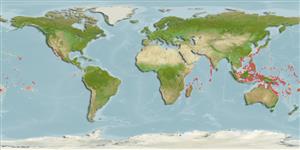Common names from other countries
Environment: milieu / climate zone / depth range / distribution range
Écologie
Récifal; profondeur 0 - 6 m (Ref. 96667). Tropical
Distribution
Pays | Zones FAO | Écosystèmes | Occurrences | Introductions
Indo-Pacific.
Length at first maturity / Taille / Poids / Âge
Maturity: Lm ? range ? - ? cm
Description synthétique
Morphologie
Small carapace has distinctly rough surface due to small granules with fine hairs as cover. Pair of pincers are unequal and covered also with very tiny granules (Ref. 128968).
May contain toxins that are undectectable in tests, and thus, may not be safe to eat (Ref. 128968). Intertidal to subtidal (Ref. 106854). Found on the reef between tide marks (Ref. 81564).
Life cycle and mating behavior
Maturité | Reproduction | Frai | Œufs | Fécondité | Larves
Members of the order Decapoda are mostly gonochoric. Mating behavior: Precopulatory courtship ritual is common (through olfactory and tactile cues); usually indirect sperm transfer.
Ward, M. 1941. (Ref. 2897)
Statut dans la liste rouge de l'IUCN (Ref. 130435)
statut CITES (Ref. 108899)
Not Evaluated
Not Evaluated
Menace pour l'homme
Poisonous to eat (Ref. 128968)
Utilisations par l'homme
| FishSource |
Outils
Plus d'informations
Taille/ÂgeCroissanceLongueur-poidsLongueur-longueurMorphologieLarvesAbondance
Sources Internet
Estimates based on models
Preferred temperature
(Ref.
115969): 24.7 - 29.2, mean 28.2 (based on 2671 cells).
Catégorie de prix
Unknown.
